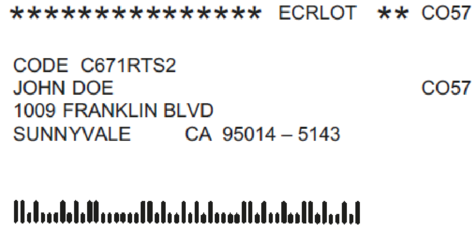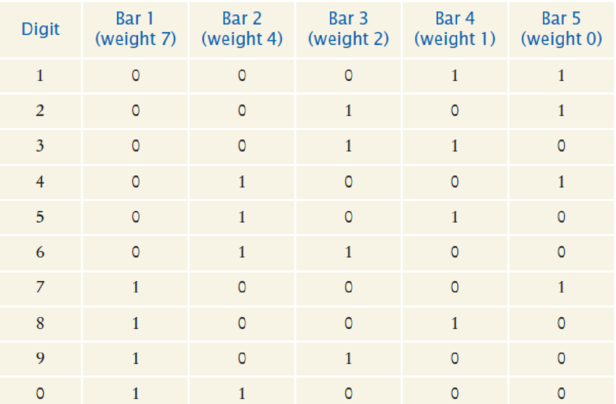
Postal bar codes. For faster sorting of letters, the United States Postal Service encourages companies that send large volumes of mail to use a bar code denoting the zip code (see Figure 7).
The encoding scheme for a five-digit zip code is shown in Figure 8. There are full-height frame bars on each side. The five encoded digits are followed by a check digit, which is computed as follows: Add up all digits, and choose the check digit to make the sum a multiple of 10. For example, the zip code 95014 has a sum of 19, so the check digit is 1 to make the sum equal to 20.

Figure 7 A Postal Bar Code

Figure 8 Encoding for Five-Digit Bar Codes
Each digit of the zip code, and the check digit, is encoded according to the table below, where 1 denotes a full bar and 0 a half bar:

The digit can be easily computed from the bar code using the column weights 7, 4, 2, 1, 0. For example, 01100 is 0 × 7 + 1 × 4 + 1 × 2 + 0 × 1 + 0 × 0 = 6. The only exception is 0, which would yield 11 according to the weight formula.
Write a program that asks the user for a zip code and prints the bar code. Use : for half bars, | for full bars. For example, 95014 becomes

Provide these methods:
public static void printDigit(int d)
public static void printBarCode(int zipCode)
Want to see the full answer?
Check out a sample textbook solution
Chapter 5 Solutions
BIG JAVA: LATE OBJECTS
Additional Engineering Textbook Solutions
Computer Science: An Overview (13th Edition) (What's New in Computer Science)
Java How to Program, Early Objects (11th Edition) (Deitel: How to Program)
Introduction To Programming Using Visual Basic (11th Edition)
Database Concepts (8th Edition)
Thinking Like an Engineer: An Active Learning Approach (4th Edition)
Modern Database Management
- For each of the following, decide whether the claim is True or False and select the True ones: Suppose we discover that the 3SAT can be solved in worst-case cubic time. Then it would mean that all problems in NP can also be solved in cubic time. If a problem can be solved using Dynamic Programming, then it is not NP-complete. Suppose X and Y are two NP-complete problems. Then, there must be a polynomial-time reduction from X to Y and also one from Y to X.arrow_forwardMaximum Independent Set problem is known to be NP-Complete. Suppose we have a graph G in which the maximum degree of each node is some constant c. Then, is the following greedy algorithm guaranteed to find an independent set whose size is within a constant factor of the optimal? 1) Initialize S = empty 2) Arbitrarily pick a vertex v, add v to S delete v and its neighbors from G 3) Repeat step 2 until G is empty Return S Yes Noarrow_forwardPlease help me answer this coding question in the images below for me(it is not a graded question):write the code using python and also provide the outputs requiredarrow_forward
- What does the reduction showing Vertex Cover (VC) is NP-Complete do: Transforms any instance of VC to an instance of 3SAT Transforms any instance of 3SAT to an instance of VC Transforms any instance of VC to an instance of 3SAT AND transforms any instance of 3SAT to an instance of VC none of the abovearrow_forwardPlease assist me by writing out the code with its output (in python) using the information provided in the 2 images below.for the IP Address, it has been changed to: 172.21.5.204the serve code has not been open yet though but the ouput must be something along these lines(using command prompt):c:\Users\japha\Desktop>python "Sbongakonke.py"Enter the server IP address (127.0.0.1 or 172.21.5.199): 172.21.5.204Enter your student number: 4125035Connected to server!It's your turn to pour! Enter the amount to your pour (in mL):Please work it out until it gets the correct outputsNB: THIS QUESTION IS NOT A GRADED QUESTIONarrow_forwardneed help with a html code and css code that will match this image.arrow_forward
- need help with a html code and css code that will match this image. Part B - A Navigation Part B is the navigation component of a page. Information you need includes: Color Codes: Visiting links: #ff6666 Unvisited links: #ccff66 Hovered links: white Search box: #2ec4b6 rebeccapurple white Font: Google Font (Roboto) Icons: Font Awesome (fa-quidditch, fa-search) This is a flexbox based navigation menu. Other then padding, all spacing/positioning should be controlled using flex properties. The home link in the nav should point to your assignment file (to triggers visited styling). In the "state" screenshot below, Home is visited, Services is hovered (the mouse doesn't show up in the screenshot) and Products is unvisited.arrow_forwardMGMT SS STATS, an umbrella body that facilitates and serves various Social Security Organizations/Departments within the Caribbean territories, stood poised to meet the needs of its stakeholders by launching an online database. The database will provide members and the public access to the complete set of services that can (also) be initiated face-to-face, and it will provide managed, private, secure access to a repository of public and/or personal information. Ideally, the database will have basic details of pension plans recorded in the registry, member plan statistics, and cash inflows and outflows from pension funds.For example, insured persons accumulate contributions. Records for these persons will include information on the insured persons able to acquire various benefits once work is interrupted due to sickness, death, retirement, and maternity or employment injury. They will also include information on pensions such as invalidity, disability, and survivors that stem from one…arrow_forwardWhy all appvif i want to sign in its required phone number why not using google or apple its make me frustratedarrow_forward
- Why is the accuracy of time important in data visualizations? Detail a scenario from your professional experience in which time was structured poorly in a data visualization. How did this affect the understanding of the data presented? How do you think this error or oversight occurred?arrow_forwardWrite the KeanStudent class. The UML diagram of the class is represented below: KeanStudent - fullName: String - keanID: int -keanEmailAddress: String cellPhoneNumber: String + numberOfStudent: int + KeanStudent() + KeanStudent(fullName: String, keanID: int, keanEmailAddress: String, cellPhoneNumber: String) +getFullName(): String +setFullName(newFullName: String): void +getKeanIDO): int +getKeanEmailAddress(): String +getCellPhoneNumber(): String + setCellPhoneNumber(newCellPhoneNumber: String): void +toString(): String 1. Implement the KeanStudent class strictly according to its UML one-to-one (do not include anything extra, do not miss any data fields or methods) 2. Implement a StudentTest class to test the class KeanStudent you just created. • Create two KeanStudent objects using a no-args constructor and one from the constructor with all fields. o Print the contents of both objects. 。 Print numberOfStudent. 3. Add comments to your program (mark where data fields, constructors,…arrow_forwardMGMT SS STATS, an umbrella body that facilitates and serves various Social SecurityOrganizations/Departments within the Caribbean territories, stoodpoised to meet the needs of its stakeholders by launching an onlinedatabase at www.SSDCI.gov. The database will provide membersand the public access to the complete set of services that can (also)be initiated face-to-face, and it will provide managed, private, secure access to a repository ofpublic and/or personal information. Ideally, the database will have basic details of pensionplans recorded in the registry, member plan statistics, and cash inflows and outflows frompension funds.For example, insured persons accumulate contributions. Records for these persons will includeinformation on the insured persons able to acquire various benefits once work is interrupteddue to sickness, death, retirement, and maternity or employment injury. They will also includeinformation on pensions such as invalidity, disability, and survivors that stem from…arrow_forward
 C++ Programming: From Problem Analysis to Program...Computer ScienceISBN:9781337102087Author:D. S. MalikPublisher:Cengage Learning
C++ Programming: From Problem Analysis to Program...Computer ScienceISBN:9781337102087Author:D. S. MalikPublisher:Cengage Learning C++ for Engineers and ScientistsComputer ScienceISBN:9781133187844Author:Bronson, Gary J.Publisher:Course Technology Ptr
C++ for Engineers and ScientistsComputer ScienceISBN:9781133187844Author:Bronson, Gary J.Publisher:Course Technology Ptr EBK JAVA PROGRAMMINGComputer ScienceISBN:9781337671385Author:FARRELLPublisher:CENGAGE LEARNING - CONSIGNMENT
EBK JAVA PROGRAMMINGComputer ScienceISBN:9781337671385Author:FARRELLPublisher:CENGAGE LEARNING - CONSIGNMENT Systems ArchitectureComputer ScienceISBN:9781305080195Author:Stephen D. BurdPublisher:Cengage LearningProgramming Logic & Design ComprehensiveComputer ScienceISBN:9781337669405Author:FARRELLPublisher:Cengage
Systems ArchitectureComputer ScienceISBN:9781305080195Author:Stephen D. BurdPublisher:Cengage LearningProgramming Logic & Design ComprehensiveComputer ScienceISBN:9781337669405Author:FARRELLPublisher:Cengage EBK JAVA PROGRAMMINGComputer ScienceISBN:9781305480537Author:FARRELLPublisher:CENGAGE LEARNING - CONSIGNMENT
EBK JAVA PROGRAMMINGComputer ScienceISBN:9781305480537Author:FARRELLPublisher:CENGAGE LEARNING - CONSIGNMENT





